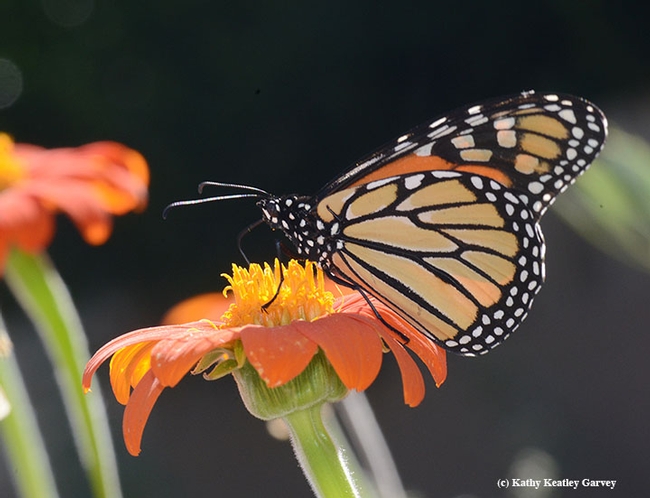- Author: Kathy Keatley Garvey
We never thought we'd see one this year.
And then it arrived.
The first monarch sighting of the year.
A Danaus plexippus majestically touched down on our Mexican sunflowers (Tithonia) around 5 this afternoon in our pollinator garden in Vacaville, circled the milkweed plants about 10 times, and then fluttered over the roof and vanished.
Meanwhile, we managed to grab a couple of photos of the iconic butterfly.
Fellow monarch enthusiasts report the scarcity of monarchs.
"Haven't see any this year," said one.
"Me, either," said another.
"No, not a single one," said yet another. "I'm looking."
Rita LeRoy has seen two at the Loma Vista Farm, Vallejo.
"Send some over to us," we said.
We remember butterfly guru Art Shapiro, UC Davis distinguished professor of evolution and ecology, commenting at a meeting hosted at UC Davis Feb. 28, 2019 by the Environmental Defense Fund, that "monarchs are on life support." The attendees--some scientists, some citizen scientists--were there to discuss "Recovering the Western Monarch Butterfly Population: Identifying Opportunities for Scaling Monarch Habitat in California's Central Valley."
The organizers related that "The latest population surveys indicate that monarchs overwintering on the central coast have declined 86% since last winter and now total 0.5% of their historical average. Population declines have spurred greater scientific study, funding, and coordination around the western monarch. California legislators appropriated $3 million in funding to the CA Wildlife Conservation Board to establish the Monarch Butterfly and Pollinator Rescue Program."
"Additionally," they said, "the Western Association of Fish and Wildlife Agencies released a Western Monarch Butterfly Conservation Plan calling for an additional 50,000 acres of monarch-friendly habitat in the California Central Valley and adjacent foothills by 2029. Join Environmental Defense Fund along with farmers, restoration practitioners, and scientists for an invitation-only workshop to share expert knowledge and identify strategic opportunities for restoring monarch butterfly habitat across the Central Valley. We will discuss important topics including opportunities for monarch habitat in the food production landscape, incentivizing monarch habitat restoration using limited resources, production and distribution of native plants, and other subjects that will put the western monarch butterfly population on the path to recovery. We will use the results of the workshop to inform conservation initiatives and effectively and efficiently allocate funds and resources for optimal conservation outcomes."
Shapiro was one of the five speakers in the "State of the Science" workshop section. He has been monitoring Central Valley's butterfly population since 1972 and maintains a website on his research.
In his presentation, Shapiro declared that "monarchs are on life support in California, and we are reduced to prescribing placebos."
"Consider a doctor faced with a patient in rapid decline," Shapiro told the group. "All tests have failed to identify the cause. What is the doctor to do? You can't prescribe treatment for an undiagnosed illness, can you? You can make a wild stab at a prescription on the basis that the patient is going to die anyway, and MAYBE, just maybe, this drug will do some good. Or you can prescribe a placebo, just to reassure the patient that you are doing something. That's where things get interesting. Occasionally a patient improves drastically on a placebo. Maybe he would have improved anyway; there's no way of knowing. Suppose our patient has a complete remission despite having received only a placebo. Does our doctor convince himself the placebo cured him? As of right now, the Monarch is on life support in California, and we are reduced to prescribing placebos. If our patient comes back from the brink—as history suggests it may well—will we convince ourselves that our placebos worked? Probably. And that's not how to do science. That's what philosophers call the fallacy of post hoc, ergo propter hoc. We can do can do better than that!" (Read his presentation on a Bug Squad blog.)
Meanwhile, we know there's at least one monarch in Vacaville...Maybe it's a female and will return to lay eggs on our milkweed. We can only hope.
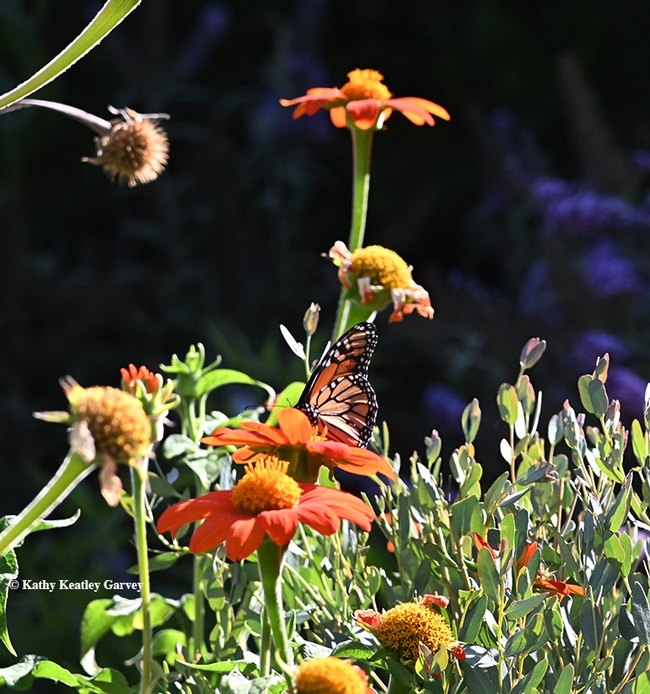
- Author: Kathy Keatley Garvey
It's Halloween and scores of trick-or-treaters are donning monarch butterfly costumes.
But they can't do justice to the living monarchs, those iconic, majestic butterflies that are always dressed in Halloween colors: black and orange.
It's always a treat to see them but they have to avoid the "tricks"--predators and parasitoids.
Among the last monarchs we reared in September: a brightly colored female, healthy and strong and rarin' to go.
Where is she now, on Halloween? Is she overwintering in Santa Cruz or Pacific Grove? Or, did a predator, perhaps a California scrub jay or a praying mantis, nail her?
We don't known "witch" way she went, but as she fluttered away, we wished her "Safe travels!"
It's been a troubling year for monarchs, Danaus plexippus, according to butterfly guru Art Shapiro, UC Davis distinguished professor of evolution and ecology, who maintains a research website, Art's Butterfly World. "I have not seen a wild egg or caterpillar of the monarch this entire calendar year at low elevations," he said Sept. 6, 2018 during an interview on the "Insight with Beth Ruyak" program, Capital Public Radio, Sacramento. "Not one." (Listen to the interview.)
Where to see the overwintering monarchs in California?
They've been found at more than 400 sites along the California coast, according to the Xerces Society for Invertebrate Conservation. "The mild winters of the California coast are a perfect haven from the harsh cold weather found in our country's interior," Xerces says on its website. "Monarchs take advantage of this climate and often use the same overwintering sites year after year. Congregations of overwintering monarchs have been found at more than 400 sites along the California coast, from Mendocino County in the north to San Diego in the south. For many people, the arrival of autumn along the California coast is marked by the flutter of orange and black as monarchs arrive at these groves and settle in for the winter."
"The last few years have witnessed low numbers of butterflies throughout the region compared to the late 1990s, but there are still many places to view overwintering monarchs and get involved!"
Check out the Xerces' map showing monarch overwintering sites in California.
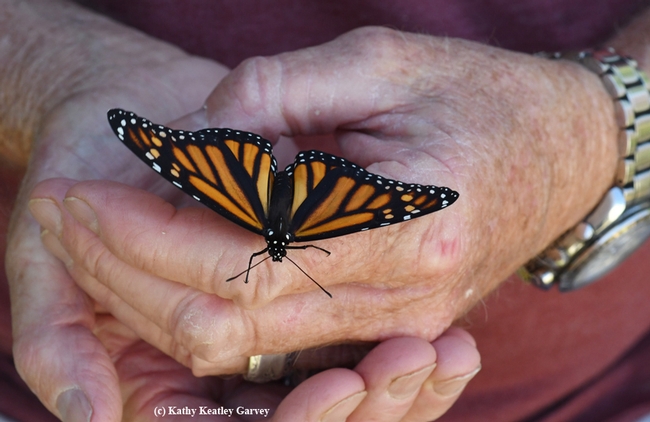
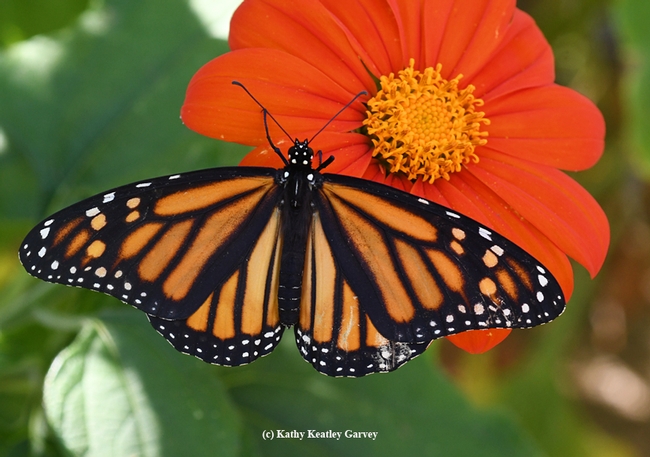
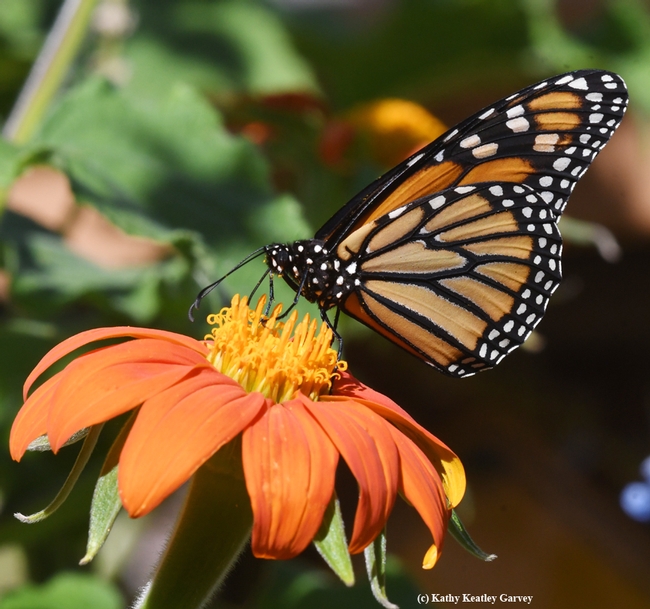
- Author: Kathy Keatley Garvey
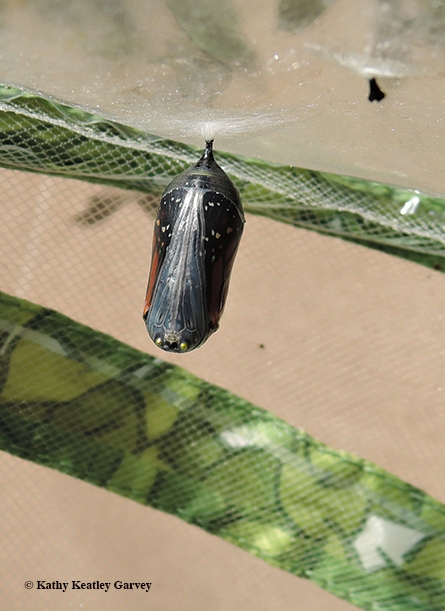
It's a magical moment.
First an egg, then a caterpillar, then a chrysalis, and then a butterfly, Danaus plexippus.
We took some images of a monarch eclosing back on Sept. 10, 2016. It was late in the season. While other monarchs were migrating to coastal California, some were fluttering into our yard in Vacaville, Calif., nectaring on blossoms, mating, and laying eggs on milkweed, their host plant.
The caterpillar, from the first instar to the fifth instar, munches the milkweed like there's no tomorrow (maybe there isn't?), and then forms an emerald green chrysalis, dotted with gold that's reminiscent of royalty. When it turns transparent, you can see the familiar black and orange wings, a promise of what's to come.
It takes about two weeks for an adult butterfly to emerge from its chrysalis and then it slides out--swoosh!--and hangs upside down, pumping fluids into its expanding wings. When the wings dry, off it goes. Sometimes it soars high into the sky. Sometimes it just lingers.
If you're a butterfly aficionado, you never get tired of watching that magical moment when a monarch ecloses.
Here's to Independence Day and to America's favorite butterfly, the monarch.
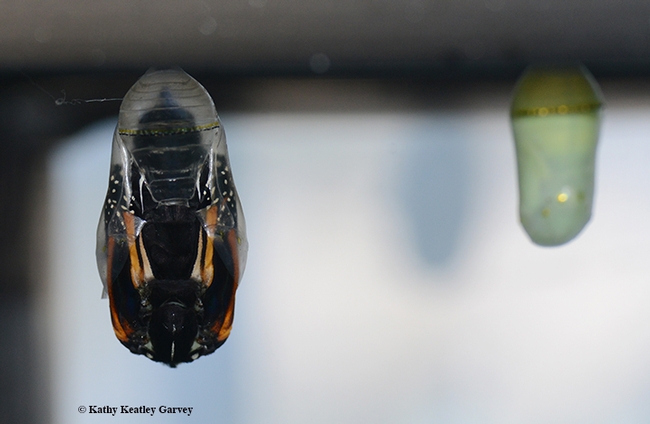
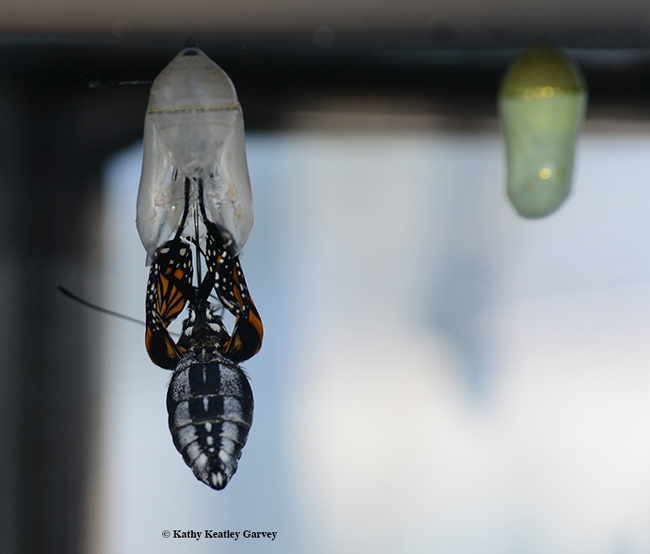
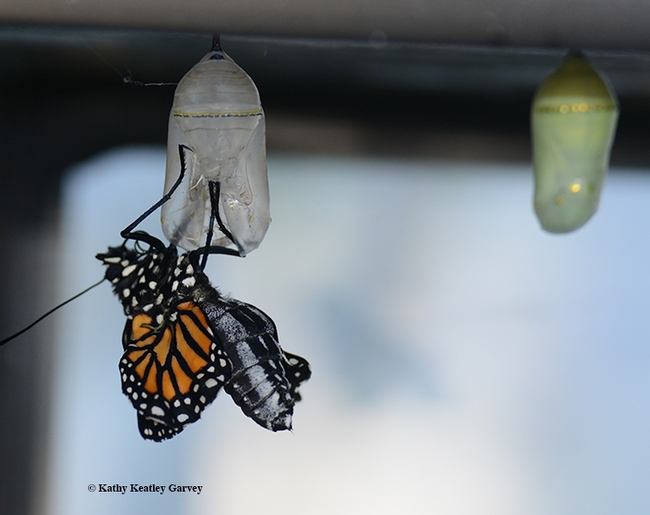
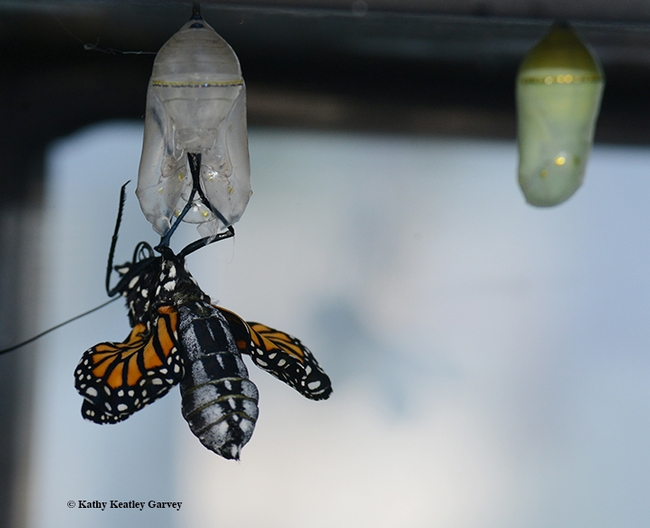
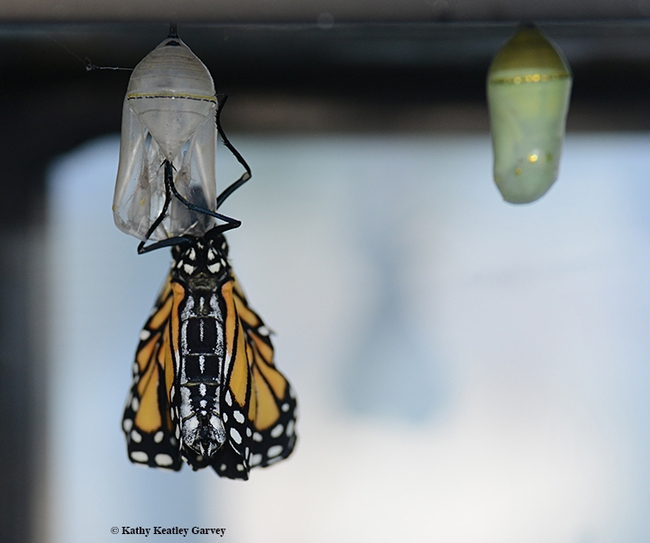
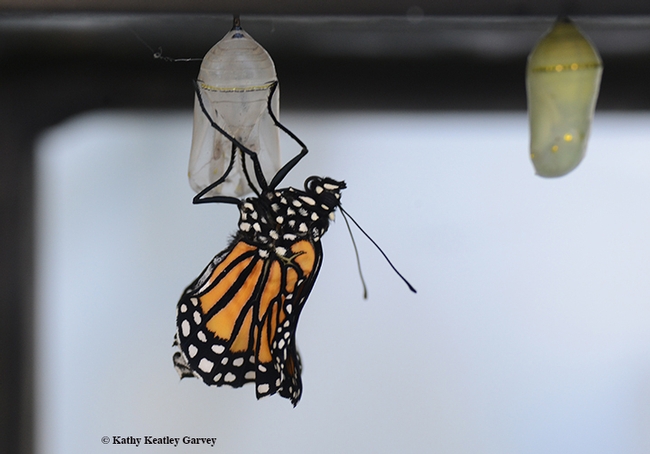
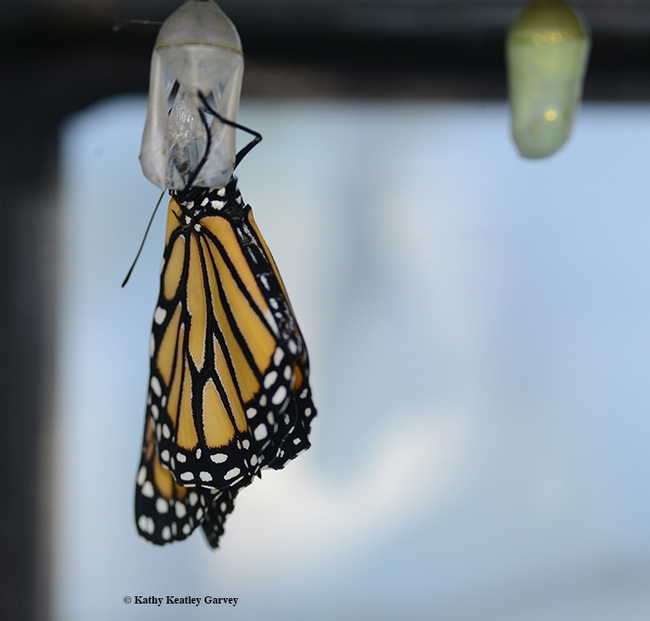
- Author: Kathy Keatley Garvey
We first saw her at 10 a.m. on Oct. 27, 2017.
She was eating. That's what monarch caterpillars do best. They eat. A lot.
"Where have you been?" I asked. "Where have you been hiding? Your siblings have long gone. Your buddies passed through here in late August and September on their way to their overwintering sites in Santa Cruz and beyond."
How could I have missed her? This one was a fifth in-star and almost ready to pupate.
"Let's see. When your mama laid the egg, you hatched in about three to four days. You'll be a caterpillar for 10 to 14 days. Then you'll be in the pupa stage for 10 to 14 days. But that's all under normal conditions, summer conditions. This is fall, not normal conditions, little buddy."
The chubby black, yellow and white monarch caterpillar kept eating. "YOU could have been eaten, little buddy," I told her, glancing at the hungry California scrub jays vocalizing in the cherry laurels. True, milkweed contains a poisonous toxin that protects monarchs from predators, but birds do eat them. "Just not as much," says Louie Yang, associate professor of entomology at the University of California, Davis.
Then there are the other deadly encounters. Tachinid flies and braconid wasps parasitize the caterpillars and chrysalids. And some fall victim to that dreaded disease, Ophryocystis elektroscirrha, caused by an obligate, protozoan parasite.
Give her a chance, just a chance...
So, awed by her unexpected appearance, we prepared the indoor butterfly habitat for its last tenant of the season. Our monarch-rearing kit features a Patron tequila bottle; the narrow neck prevents the 'cats from drowning, and the broad, heavy base assures stability (this is one bottle that doesn't get tipsy!). Just add water, milkweed stems and the caterpillar, and center the bottle in the zippered habitat. Then you wait for the caterpillar to create a silk button and form a J. And then a chrysalis. And then an adult ready to generate more generations.
This November tenant, however, chose the most fragile, overhanging milkweed stem in the bottle to pupate. No mesh ceiling for her!
When the jade-green chrysalis formed on Nov. 4, it looked like a jeweled ornament dangling from a Christmas tree. Or a mid-life chrysalis.
Now, "hurry up and wait." In ideal conditions, a monarch ecloses in 10 to 14 days. In ideal conditions.
Nothing happened for 10 days. Then 12. Then 14. Then 18.
On Day 19, Nov. 22 (the day before Thanksgiving), the chrysalis darkened, revealing the orange, black and white wings in all its transparency. The chrysalis bulged, throbbed and swayed. Out slipped the butterfly, wings flat, wings pumping. She clung to the pupal case as her wings expanded. A big, strong and healthy girl.
On Thanksgiving Day, four adults, two dogs and one butterfly celebrated in Casa de la Garvey. At least we think the butterfly celebrated. She dropped to the floor of her habitat and sipped orange juice and a honey/water mixture. Then, sustained, she fluttered up to her perch, and began searching for an opening, an escape.
She. Wanted. Out.
Hmm...No way would she be able to fly three hours to the overwintering site in Santa Cruz in the cold and rain. And then there are those hungry California scrub jays hanging out in the cherry laurels...Just waiting...
It just so happened that a friend and pollinator advocate, Rita LeRoy, the self-described "farm keeper" at the Vallejo School District's Loma Vista Farm, Vallejo, was heading to Santa Cruz on Friday, the day after Thanksgiving, to show her out-of-town relatives the overwintering migratory butterfly sanctuary at the Natural Bridges State Beach Park. That's about a 100-mile trip from Vallejo.
Could Ms. Monarch hitch a ride?
She could. And she did.
Rita, who delights in showing area schoolchildren the monarchs that frequent Loma Vista Farm--she's also a Monarch Mom who rears and releases monarchs and is active in the Bay Area Pollinator Posse--unzipped the mesh habitat at the butterfly sanctuary.
Freedom.
Her sister-in-law captured an image of Miss Monarch in freedom's hands.
Wow! Just wow! From a caterpillar to a chrysalis to an adult. And there she was! In Rita's hands. In Santa Cruz. In the migratory butterfly sanctuary. With her buddies. Or soon-to-be buddies.
"She flew so fast that we didn't get a picture of her flying away," Rita lamented. "She was anxious to join her new friends."
"It was a beautiful day," Rita said, adding "Thank you for allowing me the pleasure of setting her free. I was so sad that my last ones (monarchs) didn't survive. It was really nice to have this happy experience."
Once upon a monarch...thanks to Rita, the ending could not have been better...
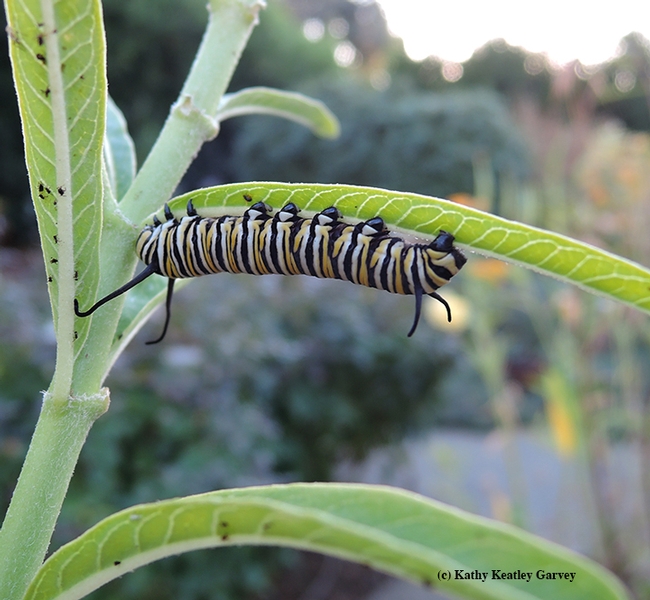
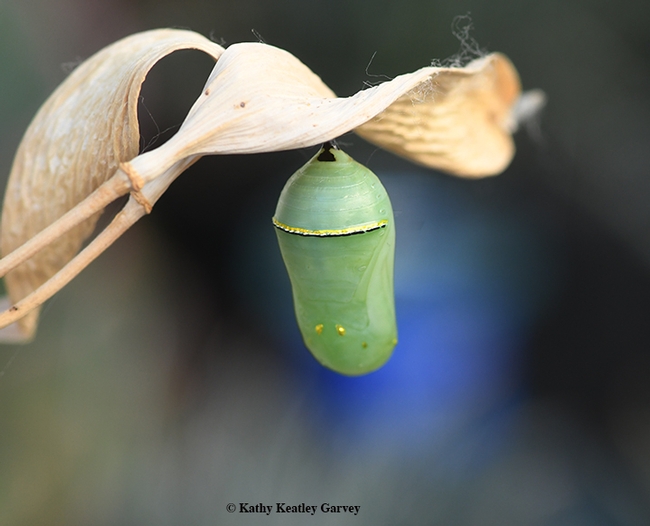
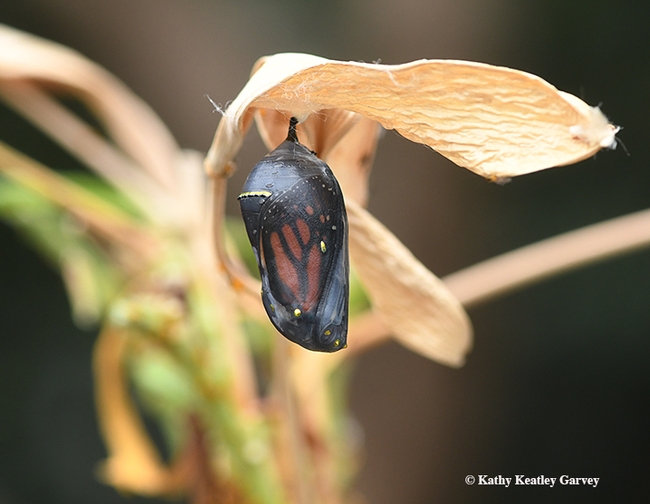
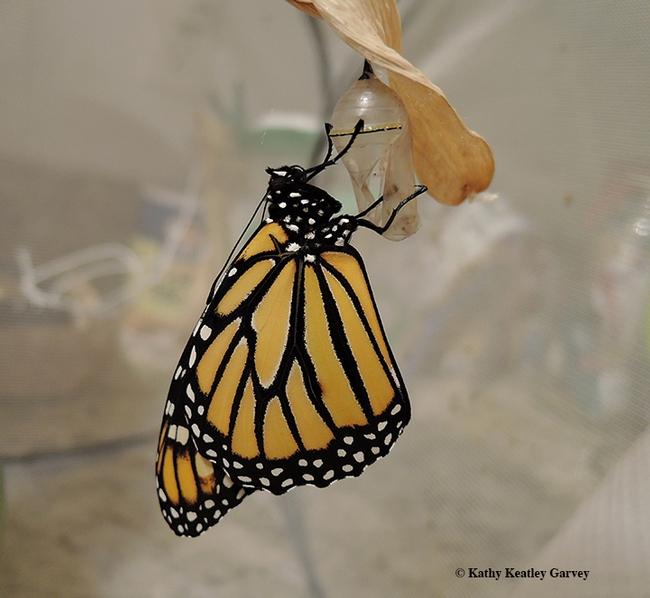
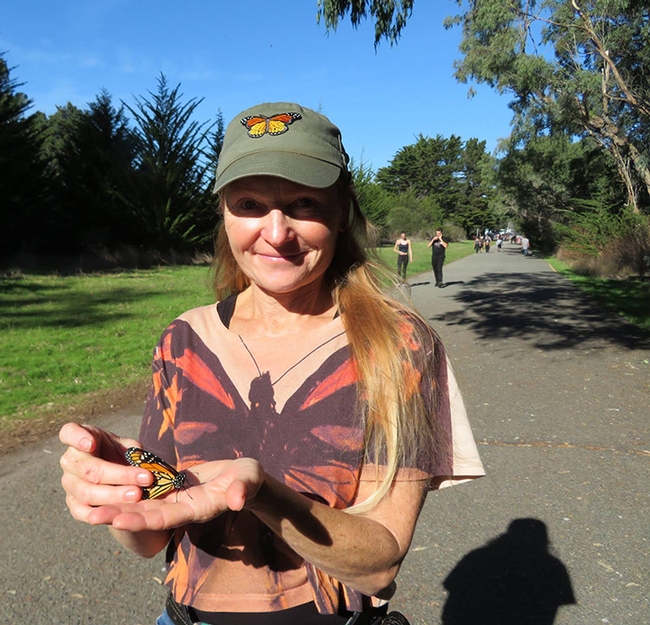
- Author: Kathy Keatley Garvey
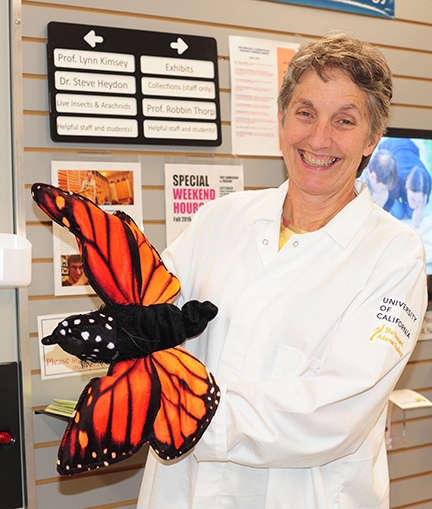
The Bohart Museum of Entomology, University of California, Davis, has butterflies in its gift shop that will never leave you, never migrate and never die.
Think stuffed animal/puppet in a zippered pouch that resembles a chrysalis. Unzip one section and out pops the familiar black, yellow and white caterpillar. Unzip another section and out pops the iconic monarch butterfly.
Monarchs are just part of the animal menagerie in the Bohart Museum gift shop. Besides the monarchs, you'll see stuffed animals resembling bed bugs, lice, tardigrades and mosquitoes. You'll find t-shirts, sweatshirts, books, posters, jewelry, insect collecting equipment and insect-themed candy, all ready for gift-giving. Proceeds benefit the Bohart's many educational and public outreach activities.
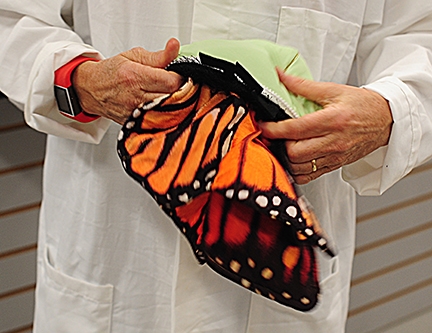
And now, mark you calendar! In keeping with the widespread interest in monarchs and other butterflies, the Bohart Museum is hosting a special open house, "Eggs to Wings: Backyard Butterfly Gardening," on Sunday, March 19. The event, free and open to the public, takes place from 1 to 4 p.m.
Meanwhile, other open houses, all scheduled from 1 to 4 p.m., will share the spotlight:
Sunday, Jan. 22: 1 to 4 p.m.: “Parasite Palooza: Botflies, Fleas and Mites, Oh, My”
Saturday, Feb. 18: (varying times throughout campus): Biodiversity Museum Day, an opportunity to explore 11 UC Davis collections
And toward the end of the academic year is the campuswide UC Davis Picnic Day, an annual open house set Saturday, April 22. The Bohart Museum will greet thousands of visitors from 10 a.m. to 3 p.m.
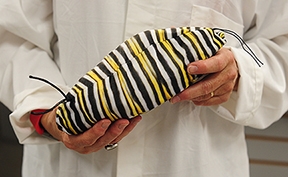
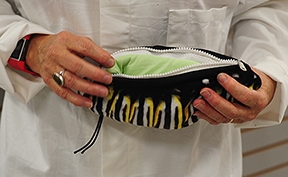
The insect museum's regular hours are from 9 a.m. to noon and 1 to 5 p.m. Mondays through Thursdays. The gift shop is open year around. The museum is closed to the public on Fridays, Saturdays and Sundays and on major holidays. Admission is free.
More information on the Bohart Museum is available by contacting (530) 752-0493 or bmuseum@ucdavis.edu. The website is http://bohart.ucdavis.edu/
